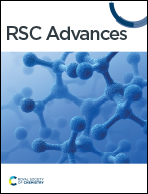Study of a three-dimensional biofilm-electrode reactor (3D-BER) that combined heterotrophic and autotrophic denitrification (HAD) to remove nitrate from water†
Abstract
A three-dimensional biofilm-electrode reactor (3D-BER) that combined heterotrophic and autotrophic denitrification (HAD) was developed to remove nitrate. The denitrification performance of the 3D-BER was evaluated under different experimental conditions, including current intensities (0–80 mA), COD/N ratios (0.5–5), and hydraulic retention times (2–12 h). The results showed that excessive current limited the nitrate removal efficiency. However, a longer hydraulic retention time was not required to achieve a better denitrification effect in the 3D-BER. Moreover, the nitrate could be effectively reduced over a broad range of COD/Ns (1–2.5), and its removal rate peaked at 89% at I = 40 mA, HRT = 8 h, and COD/N = 2. Although the current reduced the diversity of microorganisms in the system, it promoted the growth of dominant species. Nitrification microorganisms were enriched in the reactor, especially Thauera and Hydrogenophaga, which were crucial to the denitrification process. Thus, the combination of autotrophic denitrification and heterotrophic denitrification was promoted by the 3D-BER system to increase the efficiency of nitrogen removal.



 Please wait while we load your content...
Please wait while we load your content...